No matter how good your diet and training plan is, certain muscle groups are easy or hard to train (or achieve muscle fatigue), and that’s why they typically build more or less muscle mass over time.
In this article, we will go through the sixteen easiest and hardest muscles to build in our body. And we’ll get the proper strategy and workouts to hit those hard-to-grow muscle groups for better gains.
The muscle groups are ranked from easiest to hardest based on the following criteria:
- Progressive overload. We can consistently add more weight, reps, or other variables to keep driving progress. Or the muscles are capable of being progressively overloaded.
- Contraction potential. How efficiently and effectively we can apply tension to the target muscle.
- Convenience/easy to access. Most gyms should have the exercise equipment to train a particular muscle group, and people can do it without a very complex setup.
- Personal favorite. Typically I and most trainers like training that muscle group.
The muscle groups that meet a maximum of these points will be the easiest, and the least will be the hardest.
Sounds good? Let’s check out the easiest and heardest muscle groups to build.

8 Easiest Muscles to Build: Ranked
Here’re the eight muscle groups that are easy to train and build.
1. Trapezius
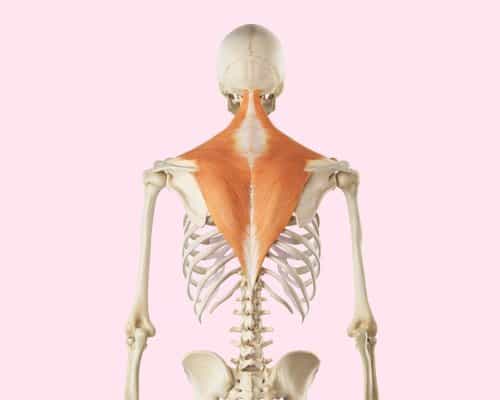
One of the easiest muscles to tear is the trapezius. This muscle starts at the base of our neck, goes across our shoulders, and ends in the middle of our back.
We can divide it into upper, middle, and lower traps.
This muscle helps us in various ways, including moving our head, neck, arms, shoulders, and torso, and help stabilizes our spine and improves posture. Well-build traps enhance our upper body appearance.
Why it’s easy to build:
Whether we’re doing heavy deadlifts or pulling something, this muscle is engaged most of the time, causing higher training frequency, making traps easy-to-grow muscle.
A bigger upper trap gives us an aesthetic look to our upper body and helps us look bigger; that’s why many people tend to hit that muscle several times per week.
When we do intensive upper back workouts, the middle and lower traps are engaged, which is also responsible for better growth.
Also, from a training perspective, most trap exercises are simple and easy, giving us a mental push not to skip the trap workout.
Here’re the best trapezius exercises:
- Farmer’s walk
- Barbell shrugs
- Face pull press
- The “Y” raise
- Prone reverse fly
Related: 9 Best Exercises for Bigger Traps
2. Rectus Femoris

The rectus femoris is part of the quadriceps group, covering the front and sides of our thighs. Its primary function is knee extension and also assists with hip flexion. It’s one of the easiest muscles to grow. Let’s know the reason.
Why it’s easy to build:
Whether we’re living a sedentary lifestyle or exercising regularly, the rectus femoris is involved in almost every movement when we try to move our body from one place to another — waking, running, etc.
This muscle is primarily engaged in most lower body exercises and assists in the upper body standing movements.
Whether we’re trying to hit the quadriceps muscle in the gym or with bodyweight movements, we can efficiently perform an extensive list of very effective exercises, making quads easy to grow.
Here’re the best quadriceps exercises:
- Squats
- Lunges
- Leg extension
- Seated leg press
- Bulgarian split squat
3. Latissimus Dorsi
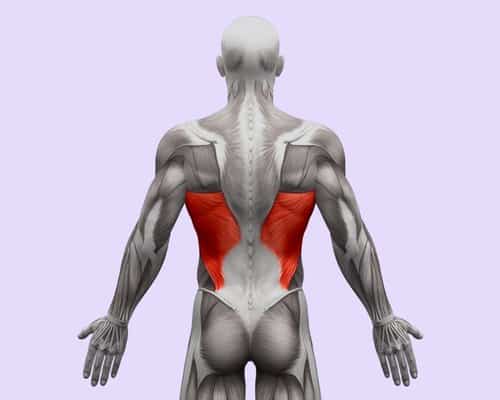
Latissimus dorsi (lats) is an easy-to-build muscle. It is a large V-shaped muscle group connecting our arms to the vertebral column.
They cover a significant part of our lower back and help protect and stabilize our spine while controlling the heavy movement of the shoulder and arm for good posture.
Why it’s easy to build:
The latissimus dorsi is often engaged in our everyday activities. These include swimming, opening a heavy door, pulling ropes, or picking up bags which develop decent lats even in a non-workout guy.
As males, we want a wider upper body, and the lat is the primary muscle responsible for that. So, we tend to hit that muscle with many different movements more than once weekly.
Also, lats have a wide range of exercises that we can easily perform to provide the maximum contraction on that muscle.
Here’re the best lats exercises:
- Lat pulldown
- Straight-arm pulldown
- Dumbbell pullover
- Dumbbell gorilla row
- Single-arm dumbbell row
Related: The Best Dumbbell Exercises for Back
4. Gluteus Maximus

The gluteus maximus is the hip’s most significant muscle, which appears on each side of the hip. This muscle is typically used for extension, external rotation, abduction, and adduction of the thighs. And due to the extensive involvement, it’s one of the easiest body parts to build muscle.
Why it’s easy to build:
The first and most obvious reason is that the gluteus maximus muscle not only activates when we primarily train it but is also very much engaged in regular activities like walking, sitting, etc.
Another reason is that this muscle can be pumped up with many exercises, especially in lower body movements (like squats, deadlifts, etc.), which increase its training volume and more muscle fatigue, which means more muscle gain.
And also, there’re many exercises we can perform to effectively train our glutes.
Here’re the best gluteus maximus exercises:
- Two-leg bridge
- Cook hip lift
- Quadruped hip extension with knee flexion
- Side plank with hip abduction
- Prone plank with hip extension
5. Triceps
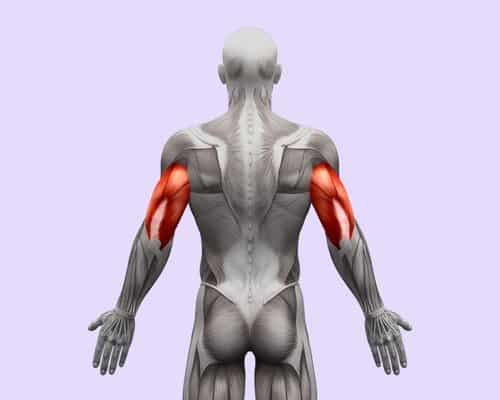
The next rank goes for the triceps, a large muscle on the back of our upper arm. It consists of three parts — lateral, long, and medial head.
This muscle is typically responsible for the extension of the elbow joints and helps straighten our arms.
Why it’s easy to build:
The main reason is that it’s easy to train and there’re various triceps exercises available that we can perform in the gym or at home.
Triceps also engaged in various heavy compound movements like bench press, military press, etc.
Also, as our arms are some of the most attractive parts of our body, we train those muscle groups several times a week, making it easy to build mass on triceps.
Here’re the best triceps exercises:
- Lying triceps extension
- Diamond pushup
- Dumbbell kickback
- Rope pushdown
- Triceps bench dips
6. Pectoralis Major

The pectoralis major is a large, fan-shaped muscle situated at the chest of our body and extends to the bone of the upper arm.
Its major functions include adduction or depression of the arm and rotation of the arm forward about the axis of the body.
Why it’s easy to build:
The chest is one of the easiest muscles to tear as it includes heavy compound movement in the routine and can be trained with barbells, dumbbells, machines, or at home.
As we can lift the heaviest weight (i.e., bench press) to train chest, it’s rear to skip chest day, especially when we’re trying to build strength and mass on the chest.
However, some genetics may not be so favorable for a big chest and if you’re in that category, try to train your chest more than once a week with heavy weights.
Here’re the best chest exercises:
- Bench press
- Dumbbell fly
- Cable crossover
- Incline dumbbell press
- Plate squeeze press
Related: 9 Exercises to Tain Your INNER Chest
7. Rhomboids

Rhomboids are also one of the easiest muscles to develop, which you may not be familiar with or trained consciously. It has two bilateral, superficial muscles located in the upper mid-back.
Together with the trapezius, levator scapulae, and latissimus dorsi, they comprise the upper layer of the extrinsic back muscles.
Why it’s easy to build:
Typically rhomboid muscles are trained several times a week, specifically when we’re following a split workout routine, because this muscle activates during the other body part exercises like the back, shoulders, and traps.
This muscle also works during heavy workouts (like deadlifts) or when we do any pulling movements in our regular life.
Here’re the best rhomboid exercises:
- Prone lateral raise
- Front raise thumbs up
- Rear delt fly
- Scapular retraction
- Scapular wall slides
8. Front Deltoid

There’re three heads in the shoulder: front, middle, and rear delts, which are incredibly important for our overall strength, healthy mobility, and the size of our upper body.
Building strong front delt can improve our pushing ability in the gym or outside.
Why it’s easy to build:
First of all, many heavy compound exercises (like bench press, shoulder press, power snatch, etc.) heavily involve the front delt, which means it is trained more frequently, leading to the fastest-growing muscles than the other two heads.
Also, there’re many exercises to train the front delt, which are pretty simple.
Remember, as the shoulder is a joint-heavy part of the body, so make sure you choose a weight that you can handle properly because an injury may prevent you from exercising for months. Lesser weight may be OK, but the incorrect form isn’t.
Here’re the best shoulder exercises:
- Barbell overhead press
- Arnold press
- Dumbbell side raise
- Face pull
- Dumbbell rear delt row
8 Hardest Muscles to Build (Ranked with Solutions)
Let’s check out the eight hardest muscles to grow with tips to build them.
1. Lower Abs
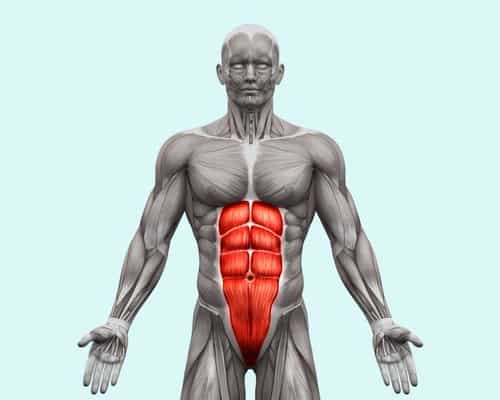
One of the hardest muscles to get visible is the lower abs which connect our upper and lower body.
Why are lower abs the hardest muscle to build:
Although we can contract the lower abs while training but it’s the area where our body loses fat at the very end compared to any other part of the body.
Also, lack of consistency in training and diet may be the reasons for not getting defined abs.
How to build lower abs:
The first tip to show your lower abs is to lower your body fat percentage.
“You’ll need to lower your body fat to about 6-13 percent for men and 14-20 percent for women in order to show your defined six-pack abs,” according to the American Council on Exercise (ACE).
Your diet is the key to losing weight. You should consistently consume a calorie deficit diet and intense abs and cardio workouts with the right frequency. Remember, taking adequate sleep and drinking enough water are also crucial.
Here’re the best lower abs exercises:
- Reverse crunch
- Front leg raise
- Hanging leg raises
- Mountain climber
- Boat pose
2. Calves
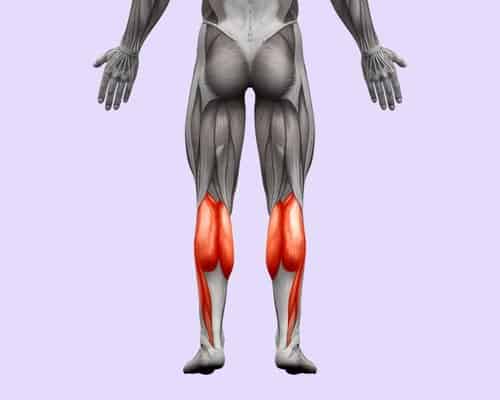
There’re two muscles in the calf, the gastrocnemius and soleus — one of the hardest muscles to properly contract and tear.
The gastrocnemius is larger and has two parts, medial and lateral. This muscle is used to get a quick burst of energy for a short period, like during sprinting.
Why are calves hard to grow:
One major reason for underdeveloped calves is low-frequency training, meaning you’re most likely to train your calves only once per week or even less than that.
Another cause is that many people aren’t correctly contracting their calf muscles, leading to less muscle stress and growth.
How to build calves:
Your priority should be hitting the calves at least 2 to 4 times a week and ensuring you’re properly squeezing and stretching your calves while training them.
Here’re the best calves exercises:
- Standing calf raises
- Seated calf raises
- Calf press on a machine
Related: How to Build Bigger Calf FAST? (Perfect Plan)
3. Obliques

The obliques are situated on the abdomen’s lateral and anterior parts. It helps rotate the trunk and pull the chest down to compress the abdominal cavity and support the spine’s rotation.
Well-developed obliques enhance a men’s attractiveness while he’s shirtless.
Why obliques are hard to build:
Like the lower abs, the obliques lie under the thick layer of fats (love handle) in our stomach.
No matter how hard we train, we must first drop our fat percentage to get defined obliques, specifically the lower ones.
And to do that, we need to be very strict on our diet and training.
Also, many people train their abs very well but not oblique, leaving them untrained and underdeveloped. So, ensure you’re hitting your obliques consistently 2-3 times a week.
Here’re the best obliques exercises:
- Side bridge
- Side crunches
- Bicycle crunches
- Downward wood chopper
- Twisting leg raises
4. Forearms

The forearm is the upper limb region between the elbow and the wrist. It contains a bunch of muscle groups such as brachioradialis, extensor muscles, and flexors muscles.
Building stronger forearms can help you in several ways, such as improving grip strength, preventing injuries, and promoting heavy gym exercises.
Why are forearms hard to grow:
The forearm muscles are involved in almost every activity we do in the gym or in regular life, causing this muscle to be familiar with the everyday workload, that’s they won’t grow easily.
Another reason would be training frequency and intensity. We most likely train our forearms at the end of our arms day or only once per week, leading to an increased chance of being ignored or less muscle pump.
Because sometimes, at the end of our workouts, we may feel low in energy or shortage of time.
How to build forearms:
To build the forearms bigger and stronger than before, we have to put heavy loads they’re unfamiliar with.
And our aim should be to train the forearms at least 2 to 3 days per week with high intensity.
Here’re the best forearm exercises:
- Reverse barbell curl
- Kneeling wrist curl
- Reverse wrist curl
- Supination and pronation
- Dead hang burnout
Related: 13 of the Best Exercises for Bigger Forearms
5. Neck

Building a thicker neck doesn’t only give an aesthetic look to your upper body but also helps reduce your neck pain and headache.
A strong neck help support the cervical spine and contribute to our head, upper back, and shoulders movements.
Why is the neck hard to build thicker:
The common reason for a thinner neck is the lack of training. Many people don’t even realize that they need (or should) to train their neck muscles.
Also, you may feel shy about working out neck muscles as it’s pretty challenging to train, and sometimes it may cause a slight headache when you just start training.
But you should know that training neck muscles consistently could reduce neck pain and headaches in the long term. (1)
How to build a bigger neck:
Working out is the number one way to build a more muscular neck.
Training about 1 to 2 times per week might be sufficient for normal people, whereas wrestlers and boxers need 3 to 4 times per week to strengthen the neck rapidly.
Here’re the best neck exercises:
- Neck curl
- Neck extension
- Neck lateral flexion
- Neck lateral rotation
- Barbell shrugs
Related: How to Get a Thicker Neck Safely?
6. Rear Deltoids

The rear deltoid is the posterior head muscle of the shoulder – one of the hardest muscles to tear. It assists us in improving posture, pulling objects, and getting attractive thicker shoulders.
Why rear deltoids hard to build:
The reason for the underdeveloped and weak rear delts is that most of the time, we tend to lift heavy, which causes a significant involvement of other muscles. As a result, less muscle contraction and minimal gains.
Another reason is that many beginners don’t train their rear delts since they’re not visible from the front.
How to build rear deltoids:
First, you should start training your rear deltoids more than once a week, specifically if it’s your weaker muscle group.
Make sure to pick a weight that you can perform the exercises with proper form and contract the muscles on every rep.
Here’re the best rear delts exercises:
- Barbell high row
- Face pulls
- Reverse pec deck flye
- Assisted pullups
- Bent over cable reverse fly
Related: The 9 Best Rear Delt Exercises
7. Hamstrings
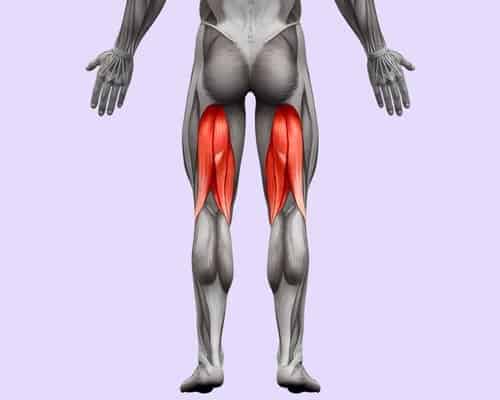
The hamstrings are a group of three muscles that predominantly act in flexion of the knee and extension of the hip.
Why hamstrings are hard to build:
One of the main reasons for an underdeveloped hamstring is that it’s quite hard to contract and fatigue this muscle fiber.
Another reason would be many gyms don’t have the special equipment to hit all three heads of the hamstring, causing less stress on the muscle.
How to build hamstrings:
If you want to get a well-developed hamstring fast, your priority should be hitting this muscle at least twice or more per week.
You should also include a stretching routine after your hamstring workout and on the rest days, which helps create space in the muscles to add more.
Here’re the best hamstring exercises:
- Lying leg curl
- Deadlift
- Razor curl
- Toes-elevated dumbbell RDL
- Dumbbell good morning
8. Biceps

Although biceps aren’t so hard to train, but one of the most challenging muscles to grow in size.
There’re two heads of the biceps: the short head and the long head. It’s one of the most demanding muscles for most young dudes.
There’s another muscle seated on the lateral part of the biceps, the brachii, which helps increase our biceps’ width.
The biceps brachii bends the forearm toward the upper arm and is used in lifting and pulling movements.
Why are biceps hard to grow:
Although training biceps is pretty simple, the problem is that most of us aren’t able to contract that muscle properly. Also, we may not consistently implement training like progressive overload or overload in and of.
However, other factors may influence your biceps growth, including age, gender, genetic predisposition, training frequency, diet, and more.
How to build biceps:
If you feel your biceps growth is stopped and won’t increase its size, you need to do something dramatically different in your arm workouts to stimulate those muscle fibers effectively.
And this could be either changing your workouts or including different variations to increase the stress on this muscle.
Tip: Choose a slightly lighter dumbbell to increase your muscle contracting ability and perform curls in a slower motion every day. Your aim should be to feel the tension every time you curl the dumbbell up.
Include the following exercises in your biceps routine to hammer it more badly. Increasing training frequency (like twice a week) and intensity can help you gain muscle fast.
Here’re the best biceps exercises:
- Barbell curl
- Chin-up
- EZ-bar preacher curl
- Hammer curl
- Incline dumbbell curl
Related: Best Exercises for Biceps Long Head
Tips to Grow the Hardest Muscles
You can implement the following tips to grow your weaker muscles.
- Train more than once a week.
- Focus on the muscle contraction with every repetition.
- Try implementing training methods like progressive overload, drop set, etc.
- Keep changing your training program every 2-3 months.
- Hit the muscle groups with various exercises.
- Eat a calorie surplus high-protein diet
- Drink more water
- Sleep well
- Be consistent
Final Word
So… There we have it: The easiest and hardest muscles to build.
Remember, how hard or easy to build any muscle group may vary from person to person, age, gender, and equipment access.
If you feel any of the muscles you have ignored or are underdeveloped, focus more on them to balance out your overall body.
I’m curious to know your opinion; which muscles did you find the easiest and hardest to grow?
For me, the easiest was the trapezius, and calves were the hardest. What’s yours?
Read Next: The Step-by-Step Formula to Build Muscle


